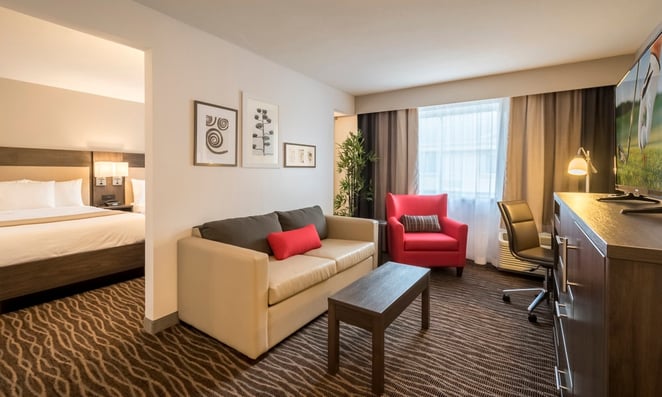
For seasoned travelers, hotel guestrooms can sometimes feel forgettable – rooms that look and feel like they could belong to any hotel, anywhere.
It’s a challenge even the most creative hoteliers face: avoiding hospitality design mistakes that come from sticking too closely to “standards” instead of crafting spaces that truly stand out.
The reality is that most design missteps happen in guest rooms, the very spaces where guests spend the majority of their time.
Thankfully, these mistakes – poor lighting, mismatched furniture, or wasted space – are completely avoidable with thoughtful planning and attention to detail.
The result? A guest experience that’s comfortable, memorable, and anything but ordinary.
Common Hospitality Design Mistakes to Watch For
Hospitality design often comes with challenges that can impact a guest's experience, but the good news is that many common mistakes are avoidable.
Let’s look at five frequent issues and practical ways to address them to create spaces that feel welcoming and functional:
-
Neglecting thoughtful lighting
-
Choosing the wrong furniture
-
Overlooking convenient power access
-
Overdoing the design
-
Wasting valuable space
1. Neglecting Thoughtful Lighting
Lighting does more than illuminate a space – it sets the tone for the entire guest experience. A well-lit room feels welcoming and functional, while poor lighting can leave guests feeling frustrated or even uncomfortable.
Guests need the right lighting in the right places to make their stay enjoyable. Imagine trying to read in bed without a nearby light or navigating a dim bathroom in the morning – it’s not a great experience.
Thoughtful lighting choices can make all the difference:
-
A lamp on the desk
-
Reading lights by the bed, with individual controls for each side
-
A soft light between seating area chairs
-
Automatic closet lighting for convenience
-
Bright, even lighting in the bathroom and entryway
Going a step further, modern lighting technology can help tailor the experience to your guests’ needs.
Circadian rhythm lighting can support their natural sleep-wake cycles, improving overall comfort. Dimmers allow guests to control the ambiance, whether they’re working, winding down, or just enjoying some quiet time.
When lighting is planned with care, it can create a warm and inviting atmosphere that makes guests feel at home.
2. Choosing the Wrong Furniture
Furniture is one of the most noticeable elements in a guestroom – and one of the easiest places to make hospitality design mistakes.
Guests may overlook minor details, but they’ll remember if furniture feels out of place, poorly made, or impractical.
Poor Fit for the Room
Furniture should complement the room’s overall design and layout. If pieces are too large, they can restrict movement for both guests and housekeeping staff.
Clashing colors, patterns, or materials can disrupt the look and feel of the space, leaving the room feeling disjointed rather than inviting.
Every piece should feel purposeful and thoughtfully chosen to support the guest experience.
Misjudged Dimensions
Poorly planned furniture dimensions can lead to frustrating situations for guests.
A headboard that blocks an outlet or a nightstand that’s too small for basic needs can create inconveniences that leave a lasting negative impression.
Working with a furniture vendor who offers site visits and a dedicated project manager (PM) helps address these issues early on.
With thoughtful planning and attention to detail, you can create rooms that are both functional and welcoming.
Looking for expert advice to avoid common mistakes and create standout spaces? Download our free guide: 14 Insider Tips for Hotel Furniture Design:
3. Overlooking Convenient Power Access
In today’s world, staying connected is part of everyday life, and guests depend on their devices for everything from work to relaxation.
That’s why it can be so frustrating to walk into a guest room and find only a couple of outlets – or worse, outlets tucked behind furniture.
Most guests bring at least two devices, like a smartphone and a tablet, but many travel with even more, especially for business. Without enough accessible outlets or USB ports, guests are left scrambling to charge their devices, which can leave a negative impression.
Here are a few ways to make electrical access easier and more intuitive:
-
Place outlets and USB ports near the bed, desk, and seating areas where guests naturally spend time.
-
Position power sources at multiple heights to suit different furniture arrangements.
-
Include furniture with built-in USB and electrical outlets for convenience, especially for business travelers.
-
Consider adding data ports for business travelers who need a reliable connection.
When guests can charge their devices easily and without hassle, it’s one less thing for them to worry about – and one more reason they’ll want to return.
4. Overdoing the Design
Every hotel has its own character, and the design should reflect that.
When the decor feels out of sync with the hotel’s purpose or audience, it can create confusion. Guests at a midscale hotel might feel out of place if the design is overly extravagant, while luxury travelers could feel underwhelmed by decor that’s too simple.
Another issue arises when designs prioritize style over usability.
Bold furniture or intricate layouts may look great in concept but can make spaces less functional.
Guests want rooms that are both visually appealing and easy to use, without feeling crowded or awkward.
Thoughtful choices create an inviting environment that feels perfectly suited to the hotel’s identity.
5. Wasting Valuable Space
Guestrooms should feel inviting and functional, offering everything guests need within the space available.
The average hotel guestroom is about 325 sq. ft. (the average hotel guest room size), making it important to carefully plan how that space is used.
Overcrowding with too much furniture can make the room feel cramped, while empty or awkwardly unused areas may feel unwelcoming.
Every square foot should serve a purpose, whether it’s providing comfort or creating a sense of openness. Thoughtfully placed furniture and a well-planned layout help strike the right balance, making the room both practical and cozy.
Frequently Asked Questions about Hospitality Design MistakesHere are some of the most frequently asked questions about hospitality design mistakes: Q: How can hotels balance individuality in design with adhering to brand standards or franchise requirements?
A: Hotels can find a middle ground between staying unique and meeting brand guidelines by focusing on areas with room for creativity. While brand standards often define things like layout or furniture choices, there’s usually flexibility in elements like artwork, lighting, and accents. By bringing in local touches – such as decor that reflects the surrounding culture or region – hotels can create a sense of place that feels special without stepping outside the boundaries of the brand. Working with experienced designers who understand both hospitality trends and brand requirements can help make the process smooth and effective. Q: How do guest preferences vary based on regional or cultural differences in hospitality design?A: Guest expectations can look very different depending on where they’re staying. In city hotels, for example, travelers might value smart layouts and practical use of space, while in a resort, they’re likely looking for more luxurious, open designs. Cultural traditions can also shape what guests look for – whether it’s lighting styles, bathroom layouts, or the overall look and feel of the space. Listening to guest feedback and paying attention to local tastes allows hotels to make thoughtful design choices that help guests feel more at home, no matter where they visit. |
Designing Better Guest Experiences
Hospitality design mistakes can disrupt a guest’s stay, but they’re also opportunities to create better spaces.
Avoiding common issues like poor lighting, impractical furniture, and inefficient layouts can transform a guestroom into a welcoming and functional retreat.
When every detail is planned with the guest experience in mind, it helps guests feel comfortable and cared for.
Addressing these hospitality design mistakes helps you create spaces that leave lasting positive impressions – and keep guests coming back.
Take Your Hotel Design to the Next Level
Ready to get started? Schedule your Value Engineering consultation today
Editor's Note: This article was originally published in February 2018 and was updated in January 2025 to reflect current industry trends.


